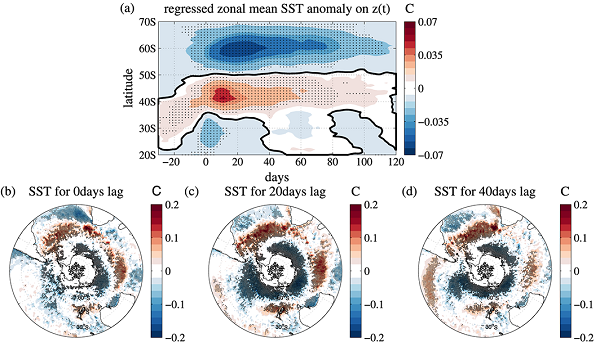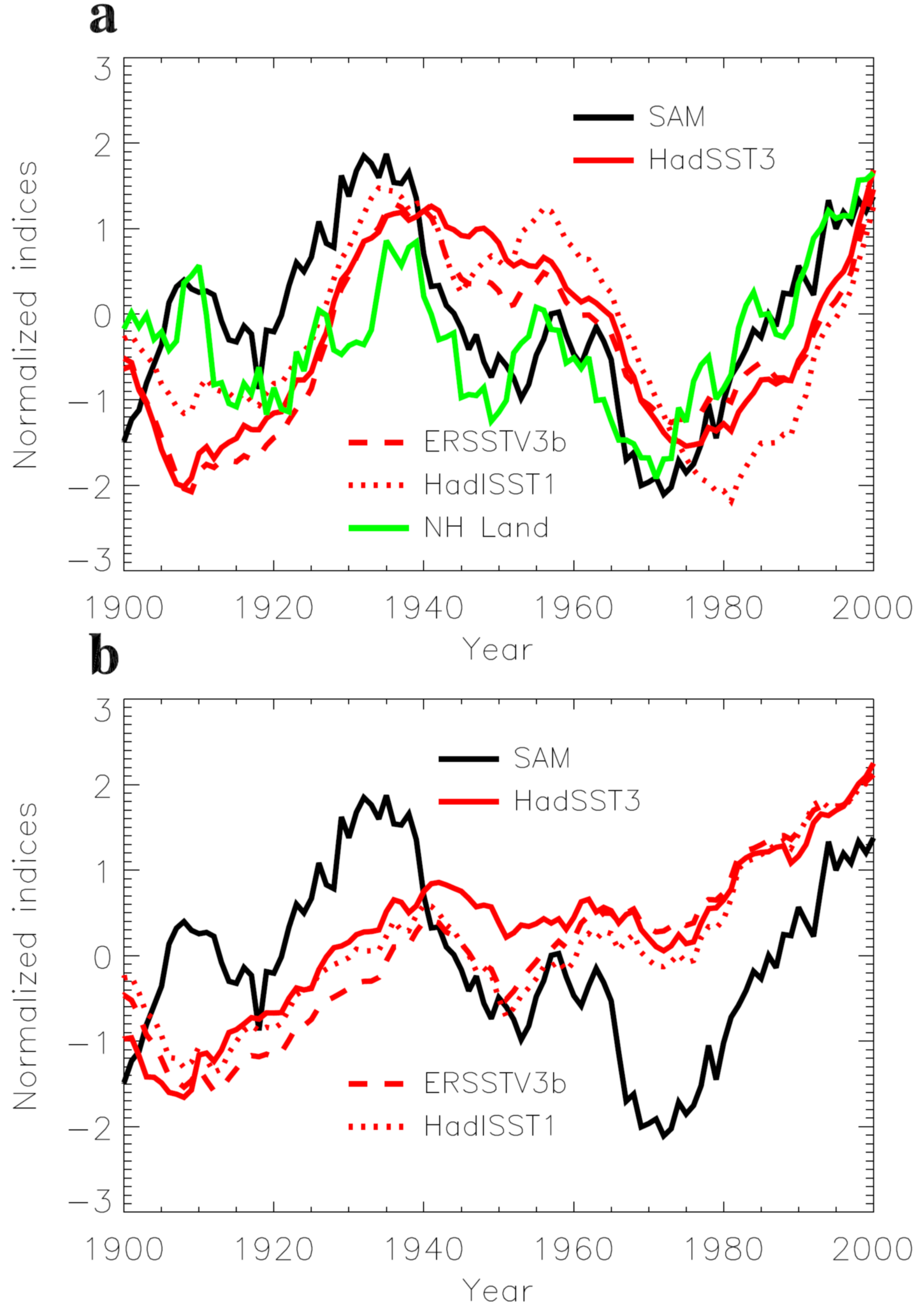



(Xiao, B., Y. Zhang*, X.-Q. Yang, and Y. Nie (2016), On the role of extratropical air-sea interaction in the persistence of the Southern Annular Mode, Geophys. Res. Lett., 43, 8806–8814, doi:10.1002/2016GL070255.)
Using the daily atmosphere and ocean reanalysis data, this study highlights the role of extratropical air-sea interaction in the variability of the Southern Annular Mode (SAM). Our analysis shows that the SAM-induced meridional dipolar sea surface temperature (SST) anomalies, through surface heat fluxes, can maintain persistent lower tropospheric temperature anomalies, which further results in anomalous eddy momentum forcing enhancing the persistence of the SAM. With the Finite Amplitude Wave Activity diagnosis, we illustrate that response of the eddy momentum forcing to SST anomalies can be attributed to changes in both baroclinic processes as baroclinic eddy generation and barotropic processes as wave breaking thus resultant diffusive eddy mixing, with the former confined at high latitudes and the latter strongest at midlatitudes. Spectral analysis further suggests that the above air-sea interactions are important for bimonthly and longer time scale SAM variations. The dipolar SST pattern may be an indicator for predicting subseasonal and interseasonal variabilities of the SAM.
 .
.
Figure 1. (a) Lagged regression of zonal mean SST anomaly based on z(t) and the horizontal patterns of regressed SST anomaly (shading) based on z(t) with z(t) leading by (b) 0 day, (c) 20 days, and (d) 40 days, respectively. In panel Figure 1a, positive lag denotes that SAM leads SST and negative lag denotes SST leading. In all panels, values significant at 90% confidence level are highlighted with black dots.
p
(Zhaomin Wang, Xiangdong Zhang, Zhaoyong Guan, Bo Sun, Xin Yang & Chengyan Liu An atmospheric origin of the multi-decadal bipolar seesaw. Scientific Reports 5, 8909; DOI:10.1038/srep08909 (2015).)
The results indicate that the strengthening (weakening) of the Southern Hemisphere westerlies can be traced to Northern Hemisphere and tropical tropospheric warming (cooling). Antarctic ozone depletion has been suggested to be an important driving force behind the recently observed increase in the Southern Hemisphere’s summer westerly winds. These results strongly imply that Northern Hemisphere and tropical warming may have played a triggering role at an stage earlier than the first detectable Antarctic ozone depletion, and enhanced Antarctic ozone depletion through decreasing the lower stratospheric temperature.
oN from HadSST3 SST, from ERSSTV3b, and from HadISST; and averaged SAT over the NH land mass. Time series are smoothed by applying the 11-year running mean, detrended, and normalized. The correlation coefficients between the SAM index and the AMO indices and averaged SAT over the NH land mass after 1950 are 0.76 (p<0.01) for HadSST3, 0.79 (p<0.01) for ERSSTV3b, 0.50 (p<0.01) for HadISST, and 0.88 (p<0.01) for averaged SAT over the NH land mass. b, The time series of averaged SST anomalies over 20oS-20oN and the SAM index. Time series of SST anomalies (relative to their means over the whole period) are smoothed by applying the 11-year running mean and normalized, but not detrended. Note that the result derived from the recently updated uninterpolated SST compilation, HadSST3, shows a clear cooling period between the 1940s and the 1970s. The correlation coefficients between the SAM index and the tropical surface temperatures after 1950 are 0.88 (p<0.01) for HadSST3, 0.81 (p<0.01) for ERSSTV3b, and 0.76 (p<0.01) for HadISST. The significance levels of the correlations are determined by using the non-parametric random phase method.
© 2014 Mokaine. All Rights Reserved.More Templates - Collect from
Lorem ipsum dolor sit amet, consectetur adipisicing elit, sed do eiusmod.